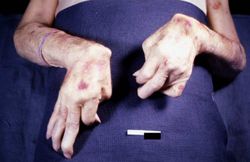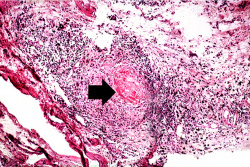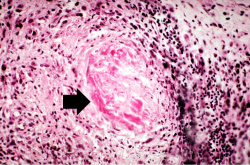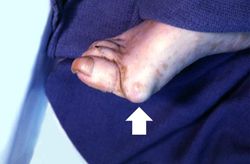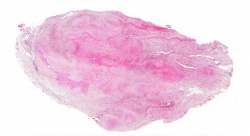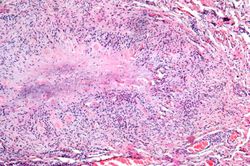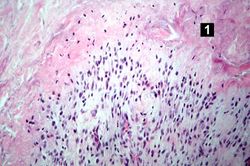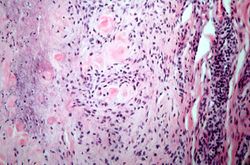Difference between revisions of "IPLab:Lab 6:Rheumatoid Arthritis"
Seung Park (talk | contribs) |
(→Images) |
||
| (8 intermediate revisions by 2 users not shown) | |||
| Line 1: | Line 1: | ||
| + | == Clinical Summary == | ||
| + | This 73-year-old female had suffered from rheumatoid arthritis for 40 years. She took large doses of aspirin in addition to her prescribed medications. The patient was came to the emergency room for weakness and hematemesis. Her hematocrit was 21%. Endoscopy demonstrated a large bleeding ulcer and fresh blood in the stomach. The sites of bleeding were cauterized; however, shortly after the procedure the patient became hypotensive and died despite aggressive resuscitation. | ||
| + | |||
| + | There were numerous erosions and ulcers in the stomach and a large quantity of fresh blood in the gastrointestinal tract. There was also significant swelling and deformation in multiple joints. On the medial aspect of the right foot there was a firm, irregular, rubbery subcutaneous nodule measuring. The cut surface was whitish-yellow and fibrous. | ||
| + | |||
== Images == | == Images == | ||
<gallery heights="250px" widths="250px"> | <gallery heights="250px" widths="250px"> | ||
File:IPLab6RA1.jpg|This is a gross photograph of the patient's hands at autopsy. Note the swollen joints and the deforming arthritis. | File:IPLab6RA1.jpg|This is a gross photograph of the patient's hands at autopsy. Note the swollen joints and the deforming arthritis. | ||
| − | File: | + | File:IPLab6RA2b.jpg|This is a medium-power photomicrograph of the joint capsule surrounding the metacarpal joints. Note the thickening of the capsule and the focal accumulation of inflammatory cells surrounding a central area of fibrinoid necrosis (arrow). |
| − | File: | + | File:IPLab6RA3b.jpg|This is a high-power photomicrograph of the joint capsule with another granuloma surrounding a central area of fibrinoid necrosis (arrow). |
File:IPLab6RA4.jpg|This is a gross photograph of the foot from this same patient. Note the subcutaneous nodule on the medial aspect of the foot (arrow). | File:IPLab6RA4.jpg|This is a gross photograph of the foot from this same patient. Note the subcutaneous nodule on the medial aspect of the foot (arrow). | ||
| − | File: | + | File:IPLab6RA5b.jpg|This is a low-power photomicrograph of the subcutaneous nodule from this patient. |
| − | |||
File:IPLab6RA7.jpg|This higher-power photomicrograph of the subcutaneous nodule again demonstrates the necrotic center and peripheral rim of macrophages, fibrocytes, and occasional lymphocytes. There are focal accumulations of hyaline material (fibrinoid material) within the granuloma. | File:IPLab6RA7.jpg|This higher-power photomicrograph of the subcutaneous nodule again demonstrates the necrotic center and peripheral rim of macrophages, fibrocytes, and occasional lymphocytes. There are focal accumulations of hyaline material (fibrinoid material) within the granuloma. | ||
File:IPLab6RA8.jpg|This higher-power photomicrograph of the tissue illustrates the palisading nuclei of the monocytes which are located around the periphery of the central necrotic region (1). | File:IPLab6RA8.jpg|This higher-power photomicrograph of the tissue illustrates the palisading nuclei of the monocytes which are located around the periphery of the central necrotic region (1). | ||
File:IPLab6RA9.jpg|This is a high-power photomicrograph of the mononuclear cells which surround the central area of necrosis. The focal accumulations of fibrinoid material are clearly visible. Lymphocytes are present in the extreme right of this image. | File:IPLab6RA9.jpg|This is a high-power photomicrograph of the mononuclear cells which surround the central area of necrosis. The focal accumulations of fibrinoid material are clearly visible. Lymphocytes are present in the extreme right of this image. | ||
| − | |||
</gallery> | </gallery> | ||
| + | |||
| + | == Virtual Microscopy == | ||
| + | <peir-vm>IPLab6RA</peir-vm> | ||
| + | |||
| + | == Study Questions == | ||
| + | * <spoiler text="What is pannus?">Inflamed and hyperemic synovium.</spoiler> | ||
| + | * <spoiler text="How common are rheumatoid nodules and what are they?">Rheumatoid nodules occur in 25% of patients with rheumatoid arthritis (RA). Rheumatoid nodules occur on pressure points (elbows, occiput, lumbosacral area, foot) and are composed of a central area of fibrinoid necrosis surrounded by a rim of epithelioid macrophages, lymphocytes, and plasma cells. The morphology of the rheumatoid nodule is similar to the tissue reaction seen in the joints.</spoiler> | ||
| + | * <spoiler text="The exact pathogenesis of rheumatoid arthritis (RA) is not known. What are some of the factors that are associated with RA?">Genetic susceptibility, exposure to a primary exogenous arthritogen, an autoimmune reaction within the synovial membranes, and release of cytokines that mediate joint damage.</spoiler> | ||
| + | * <spoiler text="What is rheumatoid factor?">IgM antibodies (perhaps originating from the joints) that are directed against the Fc portion of autologous IgG.</spoiler> | ||
| + | |||
| + | == Additional Resources == | ||
| + | === Reference === | ||
| + | * [http://emedicine.medscape.com/article/331715-overview eMedicine Medical Library: Rheumatoid Arthritis] | ||
| + | * [http://www.merckmanuals.com/professional/musculoskeletal_and_connective_tissue_disorders/joint_disorders/rheumatoid_arthritis_ra.html Merck Manual: Rheumatoid Arthritis (RA)] | ||
| + | * [http://www.nlm.nih.gov/medlineplus/rheumatoidarthritis.html#nlmnihresources National Library of Medicine: Rheumatoid Arthritis] | ||
| + | |||
| + | === Journal Articles === | ||
| + | * Carter RA, O'Donnell K, Sachthep S, Cicuttini F, Boyd AW, Wicks IP. [http://www.ncbi.nlm.nih.gov/pubmed/11564149 Characterization of a human synovial cell antigen: VCAM-1 and inflammatory arthritis]. ''Immunol Cell Biol'' 2001 Oct;79(5):419-28. | ||
| + | |||
| + | === Images === | ||
| + | * [{{SERVER}}/library/index.php?/tags/473-rheumatoid_arthritis PEIR Digital Library: Rheumatoid Arthritis Images] | ||
| + | |||
| + | == Related IPLab Cases == | ||
| + | * [[IPLab:Lab 5:Gout|Lab 5: Gout]] | ||
{{IPLab 6}} | {{IPLab 6}} | ||
[[Category: IPLab:Lab 6]] | [[Category: IPLab:Lab 6]] | ||
Latest revision as of 20:52, 8 July 2020
Contents
Clinical Summary[edit]
This 73-year-old female had suffered from rheumatoid arthritis for 40 years. She took large doses of aspirin in addition to her prescribed medications. The patient was came to the emergency room for weakness and hematemesis. Her hematocrit was 21%. Endoscopy demonstrated a large bleeding ulcer and fresh blood in the stomach. The sites of bleeding were cauterized; however, shortly after the procedure the patient became hypotensive and died despite aggressive resuscitation.
There were numerous erosions and ulcers in the stomach and a large quantity of fresh blood in the gastrointestinal tract. There was also significant swelling and deformation in multiple joints. On the medial aspect of the right foot there was a firm, irregular, rubbery subcutaneous nodule measuring. The cut surface was whitish-yellow and fibrous.
Images[edit]
Virtual Microscopy[edit]
Study Questions[edit]
Additional Resources[edit]
Reference[edit]
- eMedicine Medical Library: Rheumatoid Arthritis
- Merck Manual: Rheumatoid Arthritis (RA)
- National Library of Medicine: Rheumatoid Arthritis
Journal Articles[edit]
- Carter RA, O'Donnell K, Sachthep S, Cicuttini F, Boyd AW, Wicks IP. Characterization of a human synovial cell antigen: VCAM-1 and inflammatory arthritis. Immunol Cell Biol 2001 Oct;79(5):419-28.
Images[edit]
Related IPLab Cases[edit]
Hematemesis is the vomiting of blood.
A hematocrit value represents the number of packed red cells in mL per 100 mL of centrifuged whole blood--expressed as a percentage. A normal hematocrit for a female is 34 to 44%.
Autoimmune disorders involve an immune response directed at the host's own cells.
